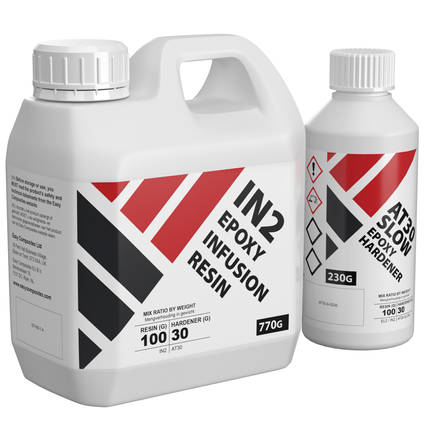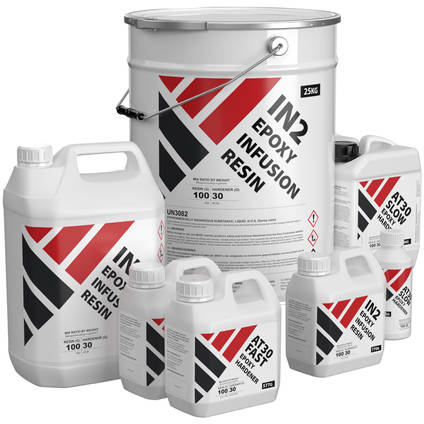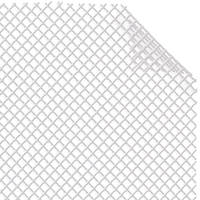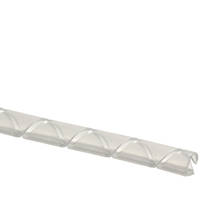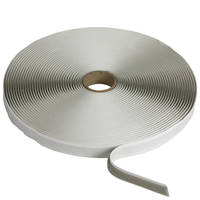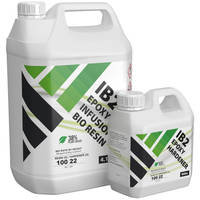Need any help or advice?+44 (0)1782 454499
Downloads (3)
This is a chemical product. Before storage or use you must download and read the accompanying safety and technical datasheets.
| Safety Datasheet (SDS) - EN | ||
| Safety Datasheet (SDS) - NL | ||
| Technical Datasheet (TDS) |
Specification
Cured Mechanical Properties
| Max Service Temp | 73 | °C |
|---|---|---|
| Compressive Strength | 80 - 100 | MPa |
| Hardness | 86 (Hard) | Shore D |
| Flexibility | Hard / Rigid | |
| Tensile Strength | 68.5 - 76 | MPa |
| Flexural Strength | 110 - 120 | MPa |
| Flexural Modulus | 3.1 - 3.5 | GPa |
| Elongation at Break | 6.0 - 8.0 | % |
| Tg Onset (DMA) | 92 - 98 | °C |
Product Data
| Colour | Clear | |
|---|---|---|
| Chemistry / Material | Epoxy | |
| Viscosity | 325 | mPa.s |
| UV Resistance | Very Good | |
| Brand | Easy Composites | |
| Shelf Life | 12 | Months |
Pot Life and Cure Times
| Pot Life (Typical) | 120 - 150 | mins |
|---|---|---|
| Initial Cure Time | 24 | Hrs |
General Properties
| Gross Weight | 1.121 | kg |
|---|
Shipping Information
Restrictions
In the currently selected pack size, this product is classed as dangerous goods in limited quantity for the purposes of transport.
Shipping is possible to all UK addresses, including the Channel Islands, without restriction. However, due to being classed as 'dangerous goods', delivery times are not guaranteed on any delivery service.
Shipping to EU countries is now done through our European subsidiary based in the Netherlands. All EU customers should use www.easycomposites.eu.
To check availability of shipping to any other country, add the item to your basket and use the shipping calculator on the basket page.
For a full information regarding the shipment of dangerous goods to all destinations, see our delivery information page.
Package Size
There are no package size restrictions or surcharges for this product.
Delivery Cost
To find the availability and cost for delivery of this item to your address, add it to your basket and then use the instant shipping calculator on the basket page.
IN2 Epoxy Infusion Resin
- EP-IN2-S-1
Hazardous
- 5/5 Average rating
IN2 is the industry standard epoxy infusion resin. Its low viscosity, clear UV stable appearance, excellent mechanical properties and variable hardener speed make it the first choice for high performance resin infusion, especially in conjunction with high performance reinforcements such as carbon fibre and Kevlar®.
Sold as a kit (resin and hardener). Available to buy online with a choice of FAST or SLOW hardener in 1kg, 5kg and 32.5kg kits.
PRODUCT VERSIONS
Kit Size
Speed
AVAILABILITY:More than 10 availablefor immediate shipping
We won’t be beaten on price!
If you believe you’re buying an equivalent product cheaper elsewhere, contact us to discuss your requirements.
This high performance epoxy resin has been specifically formulated for use in resin infusion composites production.
As an infusion epoxy it is ultra-low viscosity ensuring that is able to quickly infuse through a range of reinforcements. Its excellent mechanical strength makes it ideally suited for use with high performance reinforcements such as carbon fibre and aramids like Kevlar.
FAST and SLOW Hardeners
Our IN2 Infusion Resin is available with a choice of two hardener speeds; 'FAST' which has a pot-life of 9-14mins and is de-mouldable in around 8hrs and 'SLOW' which provides a pot-life of 80-100mins and is de-mouldable in around 24hrs. As standard we recommend using IN2 Infusion Resin with the SLOW hardener, especially for larger infusion projects. For small projects where you are confident of the infusion time, use of the FAST hardener greatly reduces the demould time. Please choose the hardener speed you want from the drop-down list at the top of the page.
In addition to the options of FAST or SLOW hardener, we have recently added the option to split the hardeners and have half FAST and half SLOW on the 1kg and 5kg kit sizes. If selected, the hardeners will therefore be supplied as one pack of FAST and one pack of SLOW at the correct proportion to the resin kit.
Unfortunately we are unable to offer mixed hardener speeds on the 500g or 32.5kg kit sizes.
FAST and SLOW hardeners can be blended to achieve pot-life and demould times anywhere between those stated in the specifications. However, you must still maintain the correct overall ratio of resin to hardener to ensure a proper cure.
Typical Uses
This is a high performance low viscosity epoxy resin formulated specifically for use in resin infusion composites production. The resin cures to a clear finish.
This is the same epoxy infusion resin that is included with our Resin Infusion Complete Starter Kit.
We also have a bio version of our infusion resin which replaces the fossil fuel based content with a bio derived alternative. You can find it here: IB2 Epoxy Infusion Bio Resin
Further Information
Managing Pot-Life During Resin Infusion
During an infusion, you can reduce the chance of the resin 'gelling' in the pot by mixing small quantities at a time and topping up the resin jug as the resin is drawn into the laminate. Once the resin is in the laminate, it is much less likely to exotherm and gel before you want it to.
Compatibility Information - Dos and Don'ts
Although by no means an exhaustive list, the mould materials, pigments and additives listed below have all been tested and are known to work well with IN2.
Compatible Moulds
- Uni-Mould Mould System
- Epoxy Tooling Gelcoat
- Epoxy gelcoat based moulds
- Polypropylene and polyethylene sheet
- Aluminium
- Toughened Glass (eg. flat sheet manufacture)
Compatible Pigments
- Epoxy Colour Pigment * (for vivid opaque colours)
- Translucent Tinting Pigment * (for less vivid opaque colours)
Compatible Fillers
- All dry filler powders
- GC50 applied to mould surface
* With bold coloured laminates, such as carbon fibre, the underlying colour of the fabric may still show through the pigmented resin. This is especially the case with Infusion resin as the nature of resin infusion is such that there is a much thinner layer of resin over the underlying laminate when compared to other processing methods.
Key Processing Information
- Ease of Use: Suitable for professional and hobby use (follow SDS advice).
- Odour: IN2 is almost odourless.
- Safety Precautions: Wear gloves and goggles and work in a well ventilated area. Always read the SDS before use.
- Ambient Conditions: Can be used from 15 to 30°C although pot-life and cure time will be affected significantly. Recommended working at an ambient of 20-25°C.
- Degassing: Not necessary in most cases. Simply mix and use. If you have excess air entrapment from mixing, let the resin pot stand for 5 minutes to allow air bubbles to escape.
- Mix Ratio: Mix 'Resin' and 'AT30 Hardener' 100:30 by weight. Use digital scales.
- Mixing: Mix thoroughly by hand for at around 2 minutes. Try to avoid excessive air entrapment.
- Pot-Life: FAST Hardener 9-14mins. SLOW Hardener 80-100mins. Be sure to use your resin before this time.
- Batch Size: Mix batch sizes appropriate to hardener speed so that resin in the pot does not begin to cure or exotherm while the infusion is in process.
- Exotherm (Over-Heating): Resin will heat-up whilst it cures. Mix in small batches and use expediently. Mixed resin in a pot will quickly overheat (exotherm) and can smoke/ignite. Never leave mixed resin unattended.
- Cure Time/Demould: At 25°C you can expect a typical cure time to be 6-8hrs for the FAST & 18-24hrs for SLOW AT30 hardeners.
- Pigments and Fillers: A wide range of pigments and fillers can be added to change the properties and appearance of Resin.
This high performance epoxy resin has been specifically formulated for use in resin infusion composites production.
As an infusion epoxy it is ultra-low viscosity ensuring that is able to quickly infuse through a range of reinforcements. Its excellent mechanical strength makes it ideally suited for use with high performance reinforcements such as carbon fibre and aramids like Kevlar.
FAST and SLOW Hardeners
Our IN2 Infusion Resin is available with a choice of two hardener speeds; 'FAST' which has a pot-life of 9-14mins and is de-mouldable in around 8hrs and 'SLOW' which provides a pot-life of 80-100mins and is de-mouldable in around 24hrs. As standard we recommend using IN2 Infusion Resin with the SLOW hardener, especially for larger infusion projects. For small projects where you are confident of the infusion time, use of the FAST hardener greatly reduces the demould time. Please choose the hardener speed you want from the drop-down list at the top of the page.
In addition to the options of FAST or SLOW hardener, we have recently added the option to split the hardeners and have half FAST and half SLOW on the 1kg and 5kg kit sizes. If selected, the hardeners will therefore be supplied as one pack of FAST and one pack of SLOW at the correct proportion to the resin kit.
Unfortunately we are unable to offer mixed hardener speeds on the 500g or 32.5kg kit sizes.
FAST and SLOW hardeners can be blended to achieve pot-life and demould times anywhere between those stated in the specifications. However, you must still maintain the correct overall ratio of resin to hardener to ensure a proper cure.
Typical Uses
This is a high performance low viscosity epoxy resin formulated specifically for use in resin infusion composites production. The resin cures to a clear finish.
This is the same epoxy infusion resin that is included with our Resin Infusion Complete Starter Kit.
We also have a bio version of our infusion resin which replaces the fossil fuel based content with a bio derived alternative. You can find it here: IB2 Epoxy Infusion Bio Resin
Further Information
Managing Pot-Life During Resin Infusion
During an infusion, you can reduce the chance of the resin 'gelling' in the pot by mixing small quantities at a time and topping up the resin jug as the resin is drawn into the laminate. Once the resin is in the laminate, it is much less likely to exotherm and gel before you want it to.
Compatibility Information - Dos and Don'ts
Although by no means an exhaustive list, the mould materials, pigments and additives listed below have all been tested and are known to work well with IN2.
Compatible Moulds
- Uni-Mould Mould System
- Epoxy Tooling Gelcoat
- Epoxy gelcoat based moulds
- Polypropylene and polyethylene sheet
- Aluminium
- Toughened Glass (eg. flat sheet manufacture)
Compatible Pigments
- Epoxy Colour Pigment * (for vivid opaque colours)
- Translucent Tinting Pigment * (for less vivid opaque colours)
Compatible Fillers
- All dry filler powders
- GC50 applied to mould surface
* With bold coloured laminates, such as carbon fibre, the underlying colour of the fabric may still show through the pigmented resin. This is especially the case with Infusion resin as the nature of resin infusion is such that there is a much thinner layer of resin over the underlying laminate when compared to other processing methods.
Key Processing Information
- Ease of Use: Suitable for professional and hobby use (follow SDS advice).
- Odour: IN2 is almost odourless.
- Safety Precautions: Wear gloves and goggles and work in a well ventilated area. Always read the SDS before use.
- Ambient Conditions: Can be used from 15 to 30°C although pot-life and cure time will be affected significantly. Recommended working at an ambient of 20-25°C.
- Degassing: Not necessary in most cases. Simply mix and use. If you have excess air entrapment from mixing, let the resin pot stand for 5 minutes to allow air bubbles to escape.
- Mix Ratio: Mix 'Resin' and 'AT30 Hardener' 100:30 by weight. Use digital scales.
- Mixing: Mix thoroughly by hand for at around 2 minutes. Try to avoid excessive air entrapment.
- Pot-Life: FAST Hardener 9-14mins. SLOW Hardener 80-100mins. Be sure to use your resin before this time.
- Batch Size: Mix batch sizes appropriate to hardener speed so that resin in the pot does not begin to cure or exotherm while the infusion is in process.
- Exotherm (Over-Heating): Resin will heat-up whilst it cures. Mix in small batches and use expediently. Mixed resin in a pot will quickly overheat (exotherm) and can smoke/ignite. Never leave mixed resin unattended.
- Cure Time/Demould: At 25°C you can expect a typical cure time to be 6-8hrs for the FAST & 18-24hrs for SLOW AT30 hardeners.
- Pigments and Fillers: A wide range of pigments and fillers can be added to change the properties and appearance of Resin.
Specification
Cured Mechanical Properties
| Max Service Temp | 73 | °C |
|---|---|---|
| Compressive Strength | 80 - 100 | MPa |
| Hardness | 86 (Hard) | Shore D |
| Flexibility | Hard / Rigid | |
| Tensile Strength | 68.5 - 76 | MPa |
| Flexural Strength | 110 - 120 | MPa |
| Flexural Modulus | 3.1 - 3.5 | GPa |
| Elongation at Break | 6.0 - 8.0 | % |
| Tg Onset (DMA) | 92 - 98 | °C |
Product Data
| Colour | Clear | |
|---|---|---|
| Chemistry / Material | Epoxy | |
| Viscosity | 325 | mPa.s |
| UV Resistance | Very Good | |
| Brand | Easy Composites | |
| Shelf Life | 12 | Months |
Pot Life and Cure Times
| Pot Life (Typical) | 120 - 150 | mins |
|---|---|---|
| Initial Cure Time | 24 | Hrs |
General Properties
| Gross Weight | 1.121 | kg |
|---|
Yes, but it's highly recommended to use specialist 'powder bound' chopped strand matt. This is because conventional chopped strand matt is 'emulsion bound' which relies on styrene and solvents in the resin to break the binding down. Epoxy does not have these solvents. As a result, specialist 'powder bound' chopped strand matt is needed as the powder binding is broken down by the liquid itself.
Most cured epoxy resins have self-extinguishing properties however none of our epoxies have formal 'fire rating' data because they're not designed as intumescent or fire retardant resins. The reinforcement you use will also have an impact on the fire retardancy of the finished product.
If you're specifically setting out to make fire-retardant parts I would suggest using a specialist intumescent resin - however, bear in mind that generally these resins will contain inert fillers which compromise their mechanical performance to some extent.
As with many post-cure cycles for resins, the post-cure cycle for our EL2 and IN2 Epoxy Resins is not too sensitive and a range of different post-cure cycles will produce good results, specifically improved mechanical performance and elevated HDT/operating temperature. Post-curing parts that will be used at or exposed to elevated operating temperatures (such as vehicle bonnets/hoods in direct sunlight, engine-bay parts, car interior parts etc.) is strongly recommended to prevent distortion of the parts when they are put into service and experience these higher temperatures.
Where possible, parts should be post-cured still inside the mould to reduce distortion and improve surface finish (i.e. reduce 'print-through'). When post-curing parts in the mould, it is important to post-cure them without demoulding at all (i.e. don’t demould and then put them back into the mould) otherwise you can get some strange patterns on the surface where some areas are post cured in direct contact with the mould surface and others are not.
A simple and very effective post-cure cycle with the IN2 Infusion Resin (or EL2 Epoxy Laminating Resin) is as follows:
CYCLE #1 SUITABLE FOR MOST SITUATIONS
- 24hrs at room temperature
- 6hrs at 60°C
If you’re encountering any surface finish issues (faint print-through) then you can experiment with a slower 'ramp rate' which sometimes improves things:
CYCLE #2 SUGGESTED FOR SUBTLE IMPROVEMENTS TO SURFACE FINISH
- 24hrs at room temperature
- 2hrs at 40°C
- 2hrs at 50°C
- 5hrs at 60°C
If you need to push the HDT of the finished part higher then you could increase post-cure up to a maximum of 80°C as follows:
CYCLE #3 SUGGESTED FOR HIGHEST POSSIBLE HDT/OPERATING TEMPERATURE
- 24hrs at room temperature
- 2hrs at 40°C
- 2hrs at 50°C
- 2hrs at 60°C
- 2hrs at 70°C
- 4hrs at 80°C
These are all just suggestions. Most situations just call for option #1; 6hrs at 60°C. Many customers also find that they can dispense with the 24hrs cure at ambient and simply load newly infused parts into the oven to begin the cure however this is something that you would need to experiment with yourself. A cure at ambient temperature before post-cure is generally favoured with most resin systems.
Uncured resins are classed as dangerous goods and would need to be disposed of correctly. For domestic users, usually your local council recycling centre will have a disposal service for such chemicals or containers.
Because cured resins are inert and safe for disposal it's often easiest to mix un-needed or out-of-date resin and hardener together to cure them. Once cured they can be disposed of with general waste.
Unlike other resin systems such as polyester or vinylester, it's very important to get the mix ratios accurate with epoxies. If you get the mix ratio wrong by a small amount (let's say a couple of grams on a small mix) then the resin will still cure but the mechanical properties won't be quite as good as they would have been if the mix ratio had been exactly right. However, if you were to be out by anything more than a few grams then you might find that the resin would not be properly hard when cured and/or may have a tackiness to the finish. This would result in a much weaker repair and needs to be avoided by careful measurements.
No, we wouldn’t suggest Epoxy Resins for lining a fuel tank. In general, epoxies have good resistance to petrol and many of the chemicals and additives found within pump fuel however the ethanol in fuel is known to cause problems over time and so specialist tank lining resins (often novalac vinylester based) should be used instead. One such product is GTS 1750 which is sold by Caswell Europe.
No, this epoxy in common with other epoxies does not attack expanded polystyrene
We have not specifically saught FDA (or similar) approval for this resin system so if you were to make these plates commercially then you would either need to make a plate using this resin system and then have it tested and approved safe for food use or use a different resin system that has specifically been approved for food use. Mixed and cured fully and properly the resulting plastic should be stable and non-toxic but testing would be required to prove this. Regarding being dishwasher safe; a dishwasher is a very harsh environment (abrasive, high temperatures, caustic) and so I think it would be quite hard on any resin system. By all means conduct your own tests but I would strongly recommend that a carbon fibre plate was not marketed as 'dishwasher safe'.
Above the HDT of a resin system it will soften slightly and its mechanical properties will start to fall away however a thermosetting plastic (like epoxy) is NOT a thermoformable plastic so it will not start to flow again such that you could melt it out of your part. It's more likely to become slightly soft and then possible more brittle again before eventually starting to burn if you too the temperature high enough. It sounds to me like you need a thermoformable plastic (aka a thermoplastic) with a relatively low melting point. I'd suggest something like PCL.
An elevated temperature post-cure is not required for parts made with epoxy resin however, post curing parts will improve the mechanical properties of the resin (and therefore the part) and so if you have the means to do it then it's certainly recommended. One major advantage to post-curing epoxy is that you will raise the HDT (heat distortion temperature) of the part meaning that it's less likely to soften or distort in higher temperatures. This can be particularly important for parts like a vehicle panel (i.e. hood/bonnet) which could get very hot in the sun. Without a post-cure there is a good chance that the part would effectively post-cure itself 'in situe' when it's in direct sunlight which can cause the resin to soften, sink and then re-harden. When this happens to a fitted part it's likely to distort the surface finish. A part that had been post-cured prior to installation would not have this problem.
Epoxy resins have very little odour and so it's quite viable to use them indoors (i.e. in your house) without upsetting anyone. The resin is almost completely odourless and the hardener has an amonia smell which doesn't really carry or linger.
In this respect epoxies are very different to polyester and vinylester resin which has a very strong smell and cannot realistically be used indoors. As always, you should still follow safety precautions and ensure adequate ventilation of your work area.
Although generally cured epoxies are non-hazardous, none of the products we have are certified food safe and thus we cannot recommend their use with food products.
We recommend Acetone. The brushes must be cleaned before the resin has cured. If you can’t get hold of acetone it’s also possible to use methylated spirits or neat alcohol.
In really simple terms you can think of 1kg of the Epoxy Resin as being 1L. If you want to be really exact (for example if you want to mix the resin and the hardener by volume and not by weight (which we don't recommend because it's unnecessarily complicated) then the relative density of the resin and the hardener, and the mixed product, can be found on the technical datasheet.
We can send any quantity of resin to Portugal. We would use a TNT Road service. To find the shipping cost for any item, simply add it to your basket and then click the 'Estimate Shipping' button on the basket page. The price will then be shown once you chose your shipping country (Portugal).
The B stage of the cure is when the resin has cured enough to be firm but still tacky. When touching with a gloved finger, the resin should feel tacky but not leave any residue on the glove.
Epoxy is sensitive to low temperatures so we would not attempt to try and cure the resin at very low temperatures such as below 15 °:C. At those temperatures, the cure time will be lengthened considerably.
One of the most significant problems caused by low temperatures (much below 20°C) is that the resin will be considerably thicker which affects its ability to self-degas after pouring.
Also, curing epoxies are hydroscopic so the low temperature environment may well leave the resin vulnerable to absorbing moisture, especially if the environment is relatively damp or high in humidity as can be found in some outdoor workshops or home garages.
As a result, for best results we always recommend working in an environment that is 20°C or above.
Assuming your plan is to resin infuse the moulds (hence choosing IN2 as the main resin) then it would be theoretically possible to use GC50 as gelcoat surface for a mould, however, there would be quite a few disadvantages to GC50 compared to the UG1 Uni-Mould Tooling Gelcoat such as it being unpigmented (you would normally want a pigment on a mould), inability to double-gelcoat (you often want a thicker gelcoat on a mould to allow for re-flatting and polishing, less hard-wearing (vinylester is much tougher than polyester) and less reliable release of epoxy (vinylesters are much more reliable as a mould surface when making epoxy components.
Also, after saying all this, GC50 also has a relatively short shelf-life of 5 months, compared to 3 months for the UG1. Given the relatively small gain in shelf life, I'd strongly suggest UG1 for tooling applications over GC50.
In terms of its mechanical integrity, the UV stability of IN2 would be perfectly fine for regular temporary outdoor use. The only affect on the resin of such use might be a slight discoloration, although I have seen components made using this resin still looking virtually the same after many years of regular outdoor use (but not permanently outdoors, which isn't recommended).
The main consideration for your project however would actually be the UV stability of the Kevlar itself. Kevlar is extremely sensitive to UV and will discolour (to a darker shade of yellow) very quickly in direct sunlight. Although the effect is mainly visual, some slight mechanical degradation will also occur with UV exposure. Therefore, for outdoor use, it would be highly recommended to protect the Kevlar from the UV light with - at least - a UV protective clearcoat or better still, an opaque paint or gelcoat.
Although you could hand laminate using IN2, it is primarily designed as a infusion resin, hence its very low viscosity. A better resin for wet lay laminating is our EL2 Epoxy Laminating Resin which has a slightly higher viscosity making it less prone to draining off vertical mould surfaces (pooling) in open layup.
Epoxy does normally release ok from Pattern Coat Primer and High Gloss. However, for slightly more aggressive processes such as resin infusion, we would recommend taking extra care with release agent application and to consider the double release agent system. This would mean applying the typical 5 coats of Easy-Lease Chemical Release Agent followed up by a couple of extra layers of Mirror Glaze Mould Release Wax for good measure. You should then get a good release.
Yes, a heated blanket can be used to fully cure/post cure resin infused components whilst still in their mould. It would be important to ensure that the distribution of temperature is even (no areas which are particularly hot or cold) but given good temperature distribution then a heated blanket is a good way of fully curing off the IN2 resin.
Yes, certainly. There are a number of established snowboard companies who use these resin systems for all their boards. IN2 and EL2 have similar cured mechanical properties meaning that the IN2 will be just as good in use for making a snowboard as the EL2 laminating resin.
Yes, this epoxy infusion resin is suitable for use with just about any reinforcement. In fact, it is approved for marine use and we supply many customers who are using this resin for carbon, kevlar, diolen and glass boat hulls.
Yes, it is. In fact we have quite a few customers who use our IN2, because of its very low viscosity and clear appearance, for stabilising wood and other natural materials. To do this properly you need to drive the resin deep into the wood which is usually done using a pressure pot. Under normal pressure the resin will soak into the wood to some effect but it won't be driven in as well as it would under positive pressure.
IN2 Epoxy Infusion Resin will coat over Styrofoam (blue expanded polystyrene foam) with no problems. It is, however, a low viscosity resin and you may find our slightly thicker EL2 Epoxy Laminating Resin more suitable for a brush application onto Styrofoam.
Yes, it is. The max temperature would be 60°:C. At this temperature the resin will cure very quickly; see the datasheet for more information on cure times and post-curing.
Our IN2 is a good choice for many marine applications such as kayaks and small watercraft. The resin combined with the infusion technique will produce a light and strong hull.
Yes our Infusion Resin will work for wet lay up, however being designed for infusion, it has a lower viscosity than a typical laminating resin. This means it is likely to run off more compared to a typical laminating resin and will not build as thick coats as quickly.
Generally for wet lay lamination, our EL2 Epoxy Laminating Resin is a superior choice of resin due to its characteristics, including slightly higher viscosity, which can make it easier to use during wet lay processes.
ASK YOUR OWN QUESTION
Customer Product Reviews for IN2 Epoxy Infusion Resin
I have tried the kit with AT30 Slow and it is perfect if you have a little larger molds, which allows the epoxy to flow in the vaccum bag without hardening. If you are going to inject smaller molds, I think the AT30 Fast or the combo with fast+slow hardener works even better.
SUBMIT YOUR OWN PRODUCT REVIEW
We publish all reviews for verified purchases. Submit your own review and help other customers with their choices.SUBMIT YOUR OWN PRODUCT REVIEW
We publish all reviews for verified purchases. Submit your own review and help other customers with their choices.Shipping Information
Restrictions
In the currently selected pack size, this product is classed as dangerous goods in limited quantity for the purposes of transport.
Shipping is possible to all UK addresses, including the Channel Islands, without restriction. However, due to being classed as 'dangerous goods', delivery times are not guaranteed on any delivery service.
Shipping to EU countries is now done through our European subsidiary based in the Netherlands. All EU customers should use www.easycomposites.eu.
To check availability of shipping to any other country, add the item to your basket and use the shipping calculator on the basket page.
For a full information regarding the shipment of dangerous goods to all destinations, see our delivery information page.
Package Size
There are no package size restrictions or surcharges for this product.
Delivery Cost
To find the availability and cost for delivery of this item to your address, add it to your basket and then use the instant shipping calculator on the basket page.
RELATED PRODUCTS
CUSTOMERS ALSO PURCHASED
RELATED PRODUCTS
CUSTOMERS ALSO PURCHASED
100% SECURE
PAYMENT METHODS


Easy Composites Ltd, registered in England 7486797. All content copyright (C) Easy Composites Ltd, 2025. All rights reserved.
